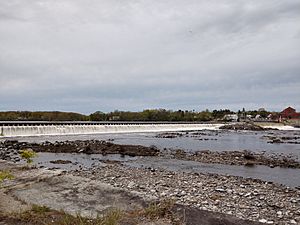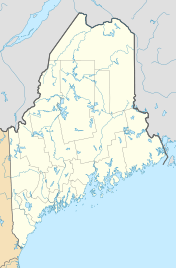Milford Dam (Maine) facts for kids
Quick facts for kids Milford Dam |
|
|---|---|

The Milford Dam, as viewed from Old Town, in May 2018.
|
|
|
Location of Milford Dam in Maine
|
|
| Country | United States |
| Location | Penobscot County, Maine |
| Coordinates | 44°56′27″N 68°38′52″W / 44.9407400°N 68.6478100°W |
| Opening date | 1906 |
| Dam and spillways | |
| Impounds | Penobscot River |
| Height | 20 ft (6 m) |
| Length | 1,400 ft (427 m) |
| Power station | |
| Commission date | 1942-1956 |
| Turbines | 5 x 1.6 MW Kaplan-type |
| Installed capacity | 8 MW |
The Milford Dam is a large structure built across the Penobscot River in Maine, United States. It sits between the towns of Old Town and Milford. Dams like this are important because they can help control water flow and create electricity.
Contents
What is the Milford Dam?
The Milford Dam was built a long time ago, opening in 1906. It stands about 20 feet (6 meters) tall and stretches for 1,400 feet (427 meters) across the river. This dam helps manage the water flow of the Penobscot River. It also plays a role in producing clean energy for the area.
Helping Fish Travel
Dams can sometimes block fish from swimming up and down rivers. This is a problem for "sea-run" fish, which need to travel from the ocean to freshwater to lay their eggs. The Milford Dam is part of a big effort to help these fish.
The Penobscot River Restoration Project
The Milford Dam is getting a new "fish lift." This is like an elevator for fish! It will help eleven different kinds of sea-run fish move past the dam. This project is part of a larger plan to restore the Penobscot River.
One important part of this plan happened in 2012. Another dam, called the Great Works Dam, was removed. It was located just downstream from the Milford Dam. Removing dams and adding fish lifts helps fish reach more of their natural habitat. This project makes the river healthier for all kinds of wildlife.
Making Clean Energy
The Milford Dam also has a power plant. This plant uses the force of the river's water to create electricity. It has five special machines called turbines. Each turbine can produce 1.6 megawatts of power.
Together, the power plant can generate 8 megawatts of electricity. This is enough power for many homes and businesses. Using river water to make electricity is a clean way to get energy. It does not create pollution like burning fossil fuels.


